大学英语听说课程教案
- 格式:docx
- 大小:15.87 KB
- 文档页数:5

Objective:To enhance students' listening and speaking skills in an English language classroom through a variety of activities that promote active engagement, critical thinking, and cultural awareness.Duration:2 hoursMaterials:- Projector and computer for multimedia presentations- Handouts with listening materials and speaking tasks- Whiteboard and markers- TimerPreparation:1. Select a range of listening materials that cater to different themes and levels of difficulty.2. Prepare handouts with questions and prompts for speaking activities.3. Familiarize yourself with the listening materials and speaking tasks to ensure smooth facilitation.4. Set up the classroom with multimedia equipment and arrange seating to encourage interaction.Lesson Outline:Warm-up (10 minutes)1. Icebreaker: Start the class with a brief icebreaker activity, such as asking students to introduce themselves and share something interesting about their country or culture. This sets a positive and engaging tone for the lesson.2. Review of Listening Skills: Briefly review key listening strategies with the students, such as predicting, note-taking, and summarizing.Listening Activity (20 minutes)1. Listening to a Podcast: Play a short podcast related to a current event or a cultural topic. Ensure the audio is at an appropriate level for the students.2. Listening for Details: As students listen, they should take notes on specific details, such as names, dates, and facts.3. Group Discussion: Divide the class into small groups and ask them to discuss the following questions:- What was the main topic of the podcast?- What were the key points discussed?- How does the topic relate to their own lives or experiences?Speaking Activity (20 minutes)1. Role-Play: Assign roles to students based on the content of the podcast. They should prepare short dialogues or monologues related to their roles.2. Group Performance: Each group presents their role-play to the class, and other students can ask questions or provide feedback.3. Peer Assessment: Students evaluate their peers based on the criteria such as fluency, pronunciation, and relevance to the topic.Cultural Awareness (10 minutes)1. Cultural Exchange: Ask students to share something about their culture that is similar to or different from what they heard in the podcast.2. Group Discussion: Discuss how cultural differences can affect communication and understanding.Reflection and Feedback (10 minutes)1. Self-Reflection: Students reflect on their listening and speaking skills and write down one thing they learned or one thing they want to improve.2. Teacher Feedback: Provide constructive feedback on the speaking activities, highlighting strengths and areas for improvement.Conclusion (10 minutes)1. Summary: Summarize the main points of the lesson and emphasize the importance of listening and speaking skills in English language learning.2. Homework Assignment: Assign a homework task that involves listening to a different podcast or watching a short video and preparing a short presentation for the next class.Assessment:- Active participation in class activities- Quality of speaking contributions- Completion of homework assignmentsNote:Ensure that the activities are adaptable to different learning styles and that students are encouraged to express their opinions and ask questions throughout the lesson.。
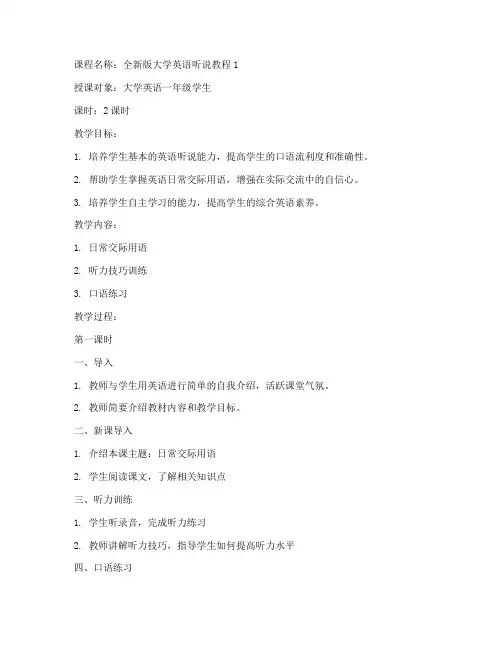
课程名称:全新版大学英语听说教程1授课对象:大学英语一年级学生课时:2课时教学目标:1. 培养学生基本的英语听说能力,提高学生的口语流利度和准确性。
2. 帮助学生掌握英语日常交际用语,增强在实际交流中的自信心。
3. 培养学生自主学习的能力,提高学生的综合英语素养。
教学内容:1. 日常交际用语2. 听力技巧训练3. 口语练习教学过程:第一课时一、导入1. 教师与学生用英语进行简单的自我介绍,活跃课堂气氛。
2. 教师简要介绍教材内容和教学目标。
二、新课导入1. 介绍本课主题:日常交际用语2. 学生阅读课文,了解相关知识点三、听力训练1. 学生听录音,完成听力练习2. 教师讲解听力技巧,指导学生如何提高听力水平四、口语练习1. 学生根据课文内容进行角色扮演2. 教师指导学生如何运用所学交际用语进行实际交流五、课堂小结1. 教师总结本课所学内容2. 学生分享学习心得第二课时一、复习导入1. 教师提问,检查学生对上一节课内容的掌握情况2. 学生复述上一节课所学交际用语二、新课导入1. 介绍本课主题:听力技巧训练2. 学生阅读课文,了解相关知识点三、听力训练1. 学生听录音,完成听力练习2. 教师讲解听力技巧,指导学生如何提高听力水平四、口语练习1. 学生根据课文内容进行角色扮演2. 教师指导学生如何运用所学交际用语进行实际交流五、课堂小结1. 教师总结本课所学内容2. 学生分享学习心得教学评价:1. 学生在课堂上的参与度和积极性2. 学生对所学内容的掌握程度3. 学生在实际交流中的运用能力教学反思:1. 教师根据学生的反馈,调整教学方法和内容2. 教师关注学生的学习需求,提高教学质量3. 教师鼓励学生自主学习,培养良好的学习习惯。
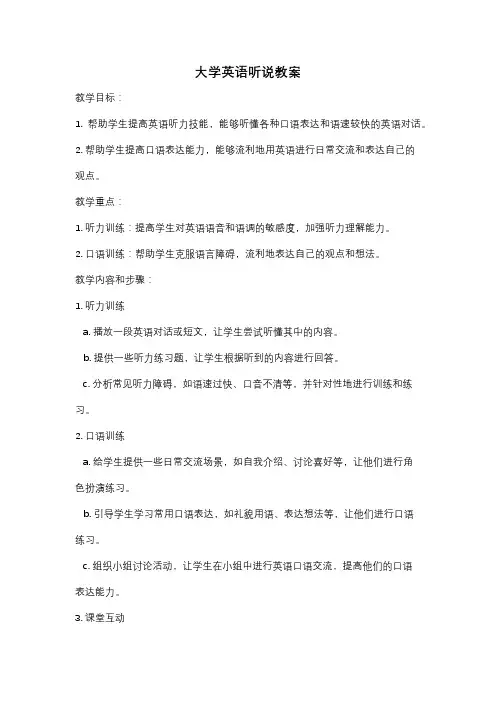
大学英语听说教案教学目标:1. 帮助学生提高英语听力技能,能够听懂各种口语表达和语速较快的英语对话。
2. 帮助学生提高口语表达能力,能够流利地用英语进行日常交流和表达自己的观点。
教学重点:1. 听力训练:提高学生对英语语音和语调的敏感度,加强听力理解能力。
2. 口语训练:帮助学生克服语言障碍,流利地表达自己的观点和想法。
教学内容和步骤:1. 听力训练a. 播放一段英语对话或短文,让学生尝试听懂其中的内容。
b. 提供一些听力练习题,让学生根据听到的内容进行回答。
c. 分析常见听力障碍,如语速过快、口音不清等,并针对性地进行训练和练习。
2. 口语训练a. 给学生提供一些日常交流场景,如自我介绍、讨论喜好等,让他们进行角色扮演练习。
b. 引导学生学习常用口语表达,如礼貌用语、表达想法等,让他们进行口语练习。
c. 组织小组讨论活动,让学生在小组中进行英语口语交流,提高他们的口语表达能力。
3. 课堂互动a. 鼓励学生积极参与课堂互动,提问、回答问题,并进行英语交流。
b. 提供各种听力和口语练习的机会,让学生在课堂上有更多的实践机会。
评估方式:1. 听力测试:通过听力测试题目,考察学生对英语听力的理解能力。
2. 口语表达:观察学生在口语练习和课堂互动中的表现,包括流利程度、表达准确性等。
教学资源:1. 英语听力材料:包括英语对话、短文等。
2. 口语练习材料:包括日常交流场景、口语表达练习等。
3. 多媒体设备:用于播放听力材料和展示口语练习内容。
教学反思:在教学过程中,要不断激发学生学习英语的兴趣,增加课堂互动和实践机会,帮助学生更好地提高英语听说能力。
同时,要关注学生的个体差异,采取灵活多样的教学方法,满足不同学生的学习需求。
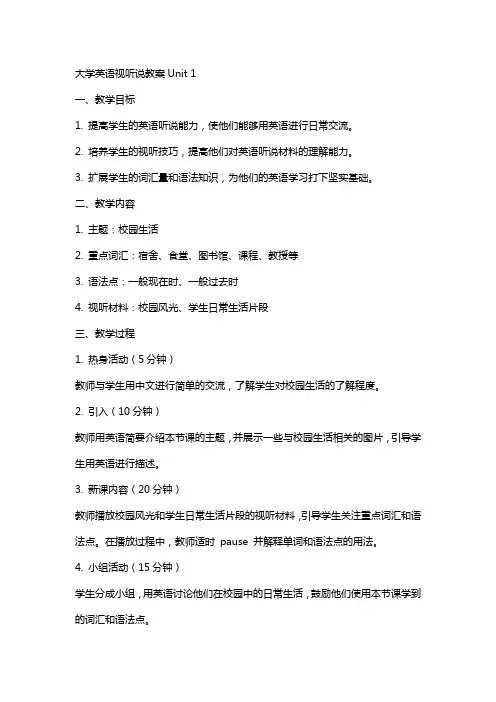
大学英语视听说教案Unit 1一、教学目标1. 提高学生的英语听说能力,使他们能够用英语进行日常交流。
2. 培养学生的视听技巧,提高他们对英语听说材料的理解能力。
3. 扩展学生的词汇量和语法知识,为他们的英语学习打下坚实基础。
二、教学内容1. 主题:校园生活2. 重点词汇:宿舍、食堂、图书馆、课程、教授等3. 语法点:一般现在时、一般过去时4. 视听材料:校园风光、学生日常生活片段三、教学过程1. 热身活动(5分钟)教师与学生用中文进行简单的交流,了解学生对校园生活的了解程度。
2. 引入(10分钟)教师用英语简要介绍本节课的主题,并展示一些与校园生活相关的图片,引导学生用英语进行描述。
3. 新课内容(20分钟)教师播放校园风光和学生日常生活片段的视听材料,引导学生关注重点词汇和语法点。
在播放过程中,教师适时pause 并解释单词和语法点的用法。
4. 小组活动(15分钟)学生分成小组,用英语讨论他们在校园中的日常生活,鼓励他们使用本节课学到的词汇和语法点。
5. 总结与作业(5分钟)教师简要总结本节课的内容,并布置作业:用英语写一篇关于校园生活的短文。
四、教学评估1. 课堂观察:观察学生在小组活动中的参与程度和语言运用能力。
2. 作业评估:评估学生对课堂所学内容的掌握程度。
五、教学资源1. 校园风光和学生日常生活片段的视听材料。
2. 相关词汇和语法点的PPT或黑板。
大学英语视听说教案Unit 2一、教学目标1. 提高学生的英语听说能力,使他们能够用英语进行日常交流。
2. 培养学生的视听技巧,提高他们对英语听说材料的理解能力。
3. 扩展学生的词汇量和语法知识,为他们的英语学习打下坚实基础。
二、教学内容1. 主题:家庭成员和亲戚2. 重点词汇:家庭成员、亲戚、外貌特征等3. 语法点:一般现在时、一般过去时4. 视听材料:家庭成员和亲戚的照片或视频三、教学过程1. 热身活动(5分钟)教师与学生用中文进行简单的交流,了解学生对家庭成员和亲戚的了解程度。
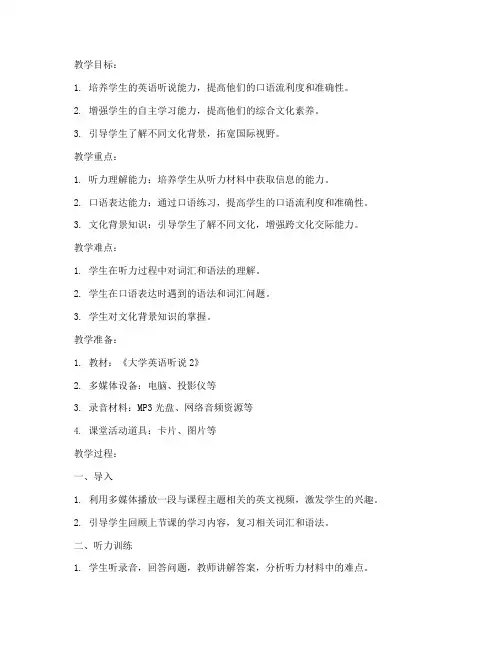
教学目标:1. 培养学生的英语听说能力,提高他们的口语流利度和准确性。
2. 增强学生的自主学习能力,提高他们的综合文化素养。
3. 引导学生了解不同文化背景,拓宽国际视野。
教学重点:1. 听力理解能力:培养学生从听力材料中获取信息的能力。
2. 口语表达能力:通过口语练习,提高学生的口语流利度和准确性。
3. 文化背景知识:引导学生了解不同文化,增强跨文化交际能力。
教学难点:1. 学生在听力过程中对词汇和语法的理解。
2. 学生在口语表达时遇到的语法和词汇问题。
3. 学生对文化背景知识的掌握。
教学准备:1. 教材:《大学英语听说2》2. 多媒体设备:电脑、投影仪等3. 录音材料:MP3光盘、网络音频资源等4. 课堂活动道具:卡片、图片等教学过程:一、导入1. 利用多媒体播放一段与课程主题相关的英文视频,激发学生的兴趣。
2. 引导学生回顾上节课的学习内容,复习相关词汇和语法。
二、听力训练1. 学生听录音,回答问题,教师讲解答案,分析听力材料中的难点。
2. 学生分小组讨论听力材料,分享自己的理解和感受。
三、口语训练1. 教师设置情景,引导学生进行口语对话。
2. 学生分小组进行角色扮演,练习口语表达。
3. 教师巡回指导,纠正学生的发音和语法错误。
四、文化背景知识1. 教师介绍与课程主题相关的文化背景知识。
2. 学生讨论文化差异,分享自己的观点。
五、小结1. 教师总结本节课的学习内容,强调重点和难点。
2. 学生回顾本节课的学习成果,提出自己的疑问。
六、作业布置1. 完成教材中的相关练习。
2. 收集与课程主题相关的英文资料,进行自主学习。
教学反思:1. 教师应根据学生的实际情况调整教学内容和进度。
2. 注重培养学生的自主学习能力,引导学生主动参与课堂活动。
3. 运用多种教学手段,激发学生的学习兴趣,提高他们的英语听说能力。
4. 关注学生的文化背景知识,增强他们的跨文化交际能力。
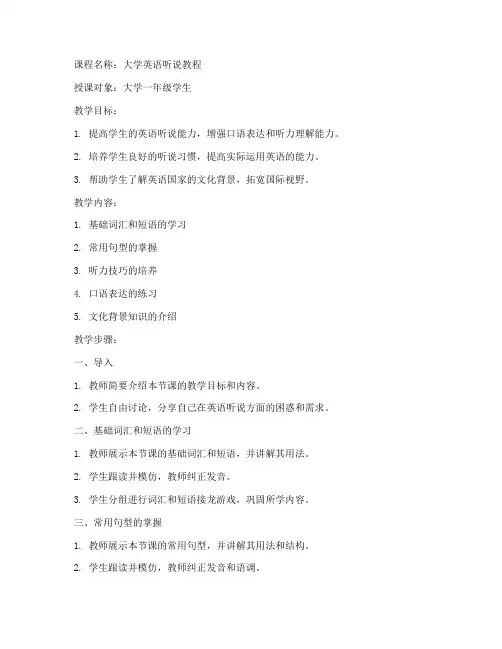
课程名称:大学英语听说教程授课对象:大学一年级学生教学目标:1. 提高学生的英语听说能力,增强口语表达和听力理解能力。
2. 培养学生良好的听说习惯,提高实际运用英语的能力。
3. 帮助学生了解英语国家的文化背景,拓宽国际视野。
教学内容:1. 基础词汇和短语的学习2. 常用句型的掌握3. 听力技巧的培养4. 口语表达的练习5. 文化背景知识的介绍教学步骤:一、导入1. 教师简要介绍本节课的教学目标和内容。
2. 学生自由讨论,分享自己在英语听说方面的困惑和需求。
二、基础词汇和短语的学习1. 教师展示本节课的基础词汇和短语,并讲解其用法。
2. 学生跟读并模仿,教师纠正发音。
3. 学生分组进行词汇和短语接龙游戏,巩固所学内容。
三、常用句型的掌握1. 教师展示本节课的常用句型,并讲解其用法和结构。
2. 学生跟读并模仿,教师纠正发音和语调。
3. 学生分组进行角色扮演,练习运用句型进行对话。
四、听力技巧的培养1. 教师播放一段听力材料,让学生进行初步的听力训练。
2. 教师分析听力材料,讲解听力技巧,如:抓关键词、预测、推理等。
3. 学生进行听力练习,教师逐题讲解答案,分析错误原因。
五、口语表达的练习1. 教师组织学生进行口语练习,如:自我介绍、话题讨论等。
2. 学生分组进行角色扮演,教师巡回指导,纠正发音和语法错误。
3. 学生展示练习成果,教师点评并给予鼓励。
六、文化背景知识的介绍1. 教师介绍与课程内容相关的文化背景知识。
2. 学生分享自己对相关文化的了解和看法。
3. 教师总结并强调文化背景知识在英语学习中的重要性。
七、总结与作业布置1. 教师对本节课的学习内容进行总结,强调重点和难点。
2. 学生进行自我评价,反思自己的学习成果。
3. 布置课后作业,如:复习所学词汇和短语、完成听力练习、准备下节课的角色扮演等。
教学反思:1. 本节课的教学效果如何?是否达到了教学目标?2. 学生在听说能力方面有哪些进步?还有哪些需要改进的地方?3. 教学方法是否适合学生?如何调整教学策略以提高教学效果?教学评价:1. 学生对英语听说教程的满意度如何?2. 学生在听说能力方面的提高情况如何?3. 教师的教学水平和教学效果如何?。
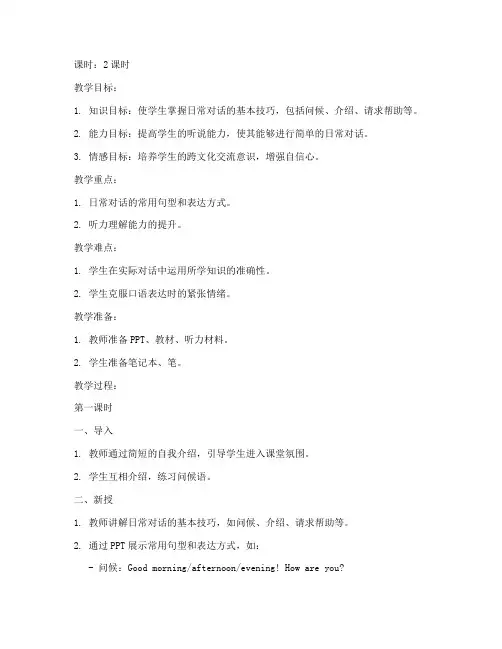
课时:2课时教学目标:1. 知识目标:使学生掌握日常对话的基本技巧,包括问候、介绍、请求帮助等。
2. 能力目标:提高学生的听说能力,使其能够进行简单的日常对话。
3. 情感目标:培养学生的跨文化交流意识,增强自信心。
教学重点:1. 日常对话的常用句型和表达方式。
2. 听力理解能力的提升。
教学难点:1. 学生在实际对话中运用所学知识的准确性。
2. 学生克服口语表达时的紧张情绪。
教学准备:1. 教师准备PPT、教材、听力材料。
2. 学生准备笔记本、笔。
教学过程:第一课时一、导入1. 教师通过简短的自我介绍,引导学生进入课堂氛围。
2. 学生互相介绍,练习问候语。
二、新授1. 教师讲解日常对话的基本技巧,如问候、介绍、请求帮助等。
2. 通过PPT展示常用句型和表达方式,如:- 问候:Good morning/afternoon/evening! How are you?- 介绍:My name is... I am from...- 请求帮助:Could you help me with...?3. 学生跟读、模仿,巩固所学知识。
三、练习1. 教师播放听力材料,让学生回答问题,如:- What is the topic of the conversation?- What are the speakers talking about?2. 学生进行角色扮演,练习日常对话。
四、小结1. 教师总结本节课所学内容,强调重点和难点。
2. 学生分享学习心得,提出疑问。
第二课时一、复习1. 教师检查学生上一节课的学习成果,提问日常对话的常用句型和表达方式。
2. 学生进行口语练习,巩固所学知识。
二、新授1. 教师讲解日常对话中的语法知识,如:- 简单的过去时态和现在进行时态。
- 疑问句和否定句。
2. 通过PPT展示例句,让学生分析语法结构。
三、练习1. 教师播放听力材料,让学生回答问题,如:- What is the speaker's purpose in this conversation?- How does the speaker express his/her feelings?2. 学生进行角色扮演,练习日常对话。
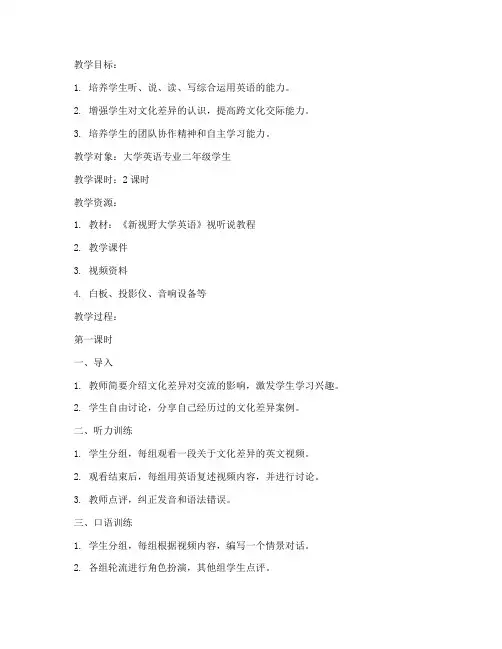
教学目标:1. 培养学生听、说、读、写综合运用英语的能力。
2. 增强学生对文化差异的认识,提高跨文化交际能力。
3. 培养学生的团队协作精神和自主学习能力。
教学对象:大学英语专业二年级学生教学课时:2课时教学资源:1. 教材:《新视野大学英语》视听说教程2. 教学课件3. 视频资料4. 白板、投影仪、音响设备等教学过程:第一课时一、导入1. 教师简要介绍文化差异对交流的影响,激发学生学习兴趣。
2. 学生自由讨论,分享自己经历过的文化差异案例。
二、听力训练1. 学生分组,每组观看一段关于文化差异的英文视频。
2. 观看结束后,每组用英语复述视频内容,并进行讨论。
3. 教师点评,纠正发音和语法错误。
三、口语训练1. 学生分组,每组根据视频内容,编写一个情景对话。
2. 各组轮流进行角色扮演,其他组学生点评。
3. 教师点评,引导学生关注文化差异在交流中的应用。
四、总结1. 教师总结本节课所学内容,强调文化差异在交流中的重要性。
2. 学生分享学习心得,提出疑问。
第二课时一、复习1. 教师提问,检查学生对上节课内容的掌握情况。
2. 学生回答问题,教师点评。
二、阅读训练1. 学生阅读教材中关于文化差异的英文文章。
2. 学生分组,每组讨论文章内容,总结文化差异的特点。
3. 各组轮流分享讨论成果,教师点评。
三、写作训练1. 学生根据教材内容,撰写一篇关于文化差异的英文短文。
2. 学生互相批改,提出修改意见。
3. 教师点评,纠正语法错误,提高写作水平。
四、总结1. 教师总结本节课所学内容,强调文化差异在交流中的重要性。
2. 学生分享学习心得,提出疑问。
教学反思:1. 本节课通过任务型教学,让学生在完成任务的过程中,提高听、说、读、写综合运用英语的能力。
2. 在教学过程中,教师应注重引导学生关注文化差异,提高跨文化交际能力。
3. 教师要善于运用多种教学资源,激发学生的学习兴趣,提高教学质量。
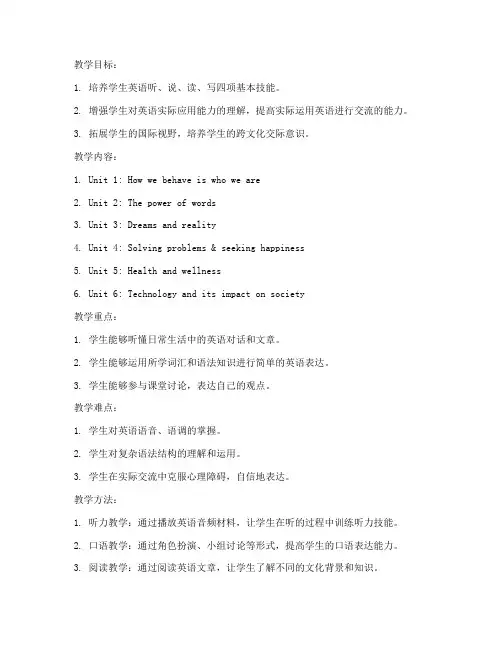
教学目标:1. 培养学生英语听、说、读、写四项基本技能。
2. 增强学生对英语实际应用能力的理解,提高实际运用英语进行交流的能力。
3. 拓展学生的国际视野,培养学生的跨文化交际意识。
教学内容:1. Unit 1: How we behave is who we are2. Unit 2: The power of words3. Unit 3: Dreams and reality4. Unit 4: Solving problems & seeking happiness5. Unit 5: Health and wellness6. Unit 6: Technology and its impact on society教学重点:1. 学生能够听懂日常生活中的英语对话和文章。
2. 学生能够运用所学词汇和语法知识进行简单的英语表达。
3. 学生能够参与课堂讨论,表达自己的观点。
教学难点:1. 学生对英语语音、语调的掌握。
2. 学生对复杂语法结构的理解和运用。
3. 学生在实际交流中克服心理障碍,自信地表达。
教学方法:1. 听力教学:通过播放英语音频材料,让学生在听的过程中训练听力技能。
2. 口语教学:通过角色扮演、小组讨论等形式,提高学生的口语表达能力。
3. 阅读教学:通过阅读英语文章,让学生了解不同的文化背景和知识。
4. 写作教学:通过写作练习,提高学生的英语写作能力。
教学过程:Unit 1: How we behave is who we are1. 导入:通过展示一些公共场所的图片,让学生思考不同的行为举止。
2. 听力训练:播放一段关于公共场所行为的英语对话,让学生听懂并复述。
3. 口语练习:分组讨论,让学生表达自己在公共场所的行为举止。
4. 阅读文章:让学生阅读一篇关于行为举止的英语文章,了解不同的文化背景。
5. 写作练习:让学生写一篇关于自己在公共场所的行为举止的短文。
Unit 2: The power of words1. 导入:通过展示一些富有感染力的语言,让学生思考语言的力量。
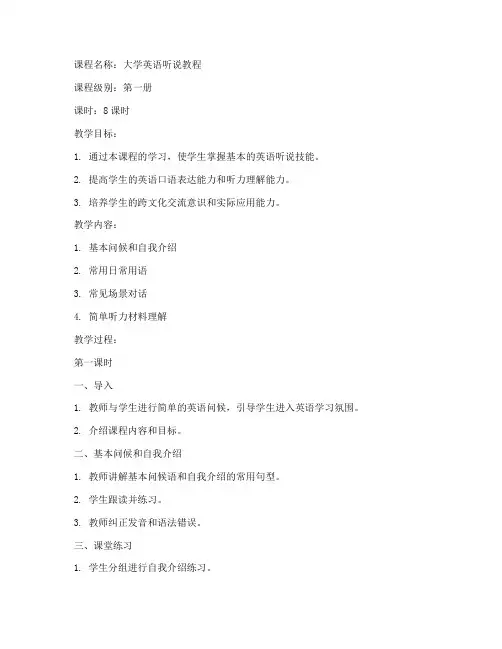
课程名称:大学英语听说教程课程级别:第一册课时:8课时教学目标:1. 通过本课程的学习,使学生掌握基本的英语听说技能。
2. 提高学生的英语口语表达能力和听力理解能力。
3. 培养学生的跨文化交流意识和实际应用能力。
教学内容:1. 基本问候和自我介绍2. 常用日常用语3. 常见场景对话4. 简单听力材料理解教学过程:第一课时一、导入1. 教师与学生进行简单的英语问候,引导学生进入英语学习氛围。
2. 介绍课程内容和目标。
二、基本问候和自我介绍1. 教师讲解基本问候语和自我介绍的常用句型。
2. 学生跟读并练习。
3. 教师纠正发音和语法错误。
三、课堂练习1. 学生分组进行自我介绍练习。
2. 教师巡回指导,纠正发音和语法错误。
第二课时一、复习上一课时的内容1. 教师提问,检查学生对基本问候和自我介绍的理解和掌握情况。
2. 学生回答问题。
二、常用日常用语1. 教师讲解常用日常用语的句型和语境。
2. 学生跟读并练习。
3. 教师纠正发音和语法错误。
三、课堂练习1. 学生分组进行日常用语对话练习。
2. 教师巡回指导,纠正发音和语法错误。
第三课时一、复习上一课时的内容1. 教师提问,检查学生对常用日常用语的理解和掌握情况。
2. 学生回答问题。
二、常见场景对话1. 教师讲解常见场景对话的句型和语境。
2. 学生跟读并练习。
3. 教师纠正发音和语法错误。
三、课堂练习1. 学生分组进行常见场景对话练习。
2. 教师巡回指导,纠正发音和语法错误。
第四课时一、复习上一课时的内容1. 教师提问,检查学生对常见场景对话的理解和掌握情况。
2. 学生回答问题。
二、简单听力材料理解1. 教师播放一段简单的英语听力材料。
2. 学生听并回答问题。
3. 教师讲解听力材料的内容和答案。
三、课堂练习1. 学生分组进行听力练习。
2. 教师巡回指导,纠正发音和语法错误。
第五课时一、复习上一课时的内容1. 教师提问,检查学生对简单听力材料理解的理解和掌握情况。

教学目标:1. 让学生掌握本单元的词汇和短语。
2. 提高学生的听力理解能力,能够理解日常生活中的简单对话和短文。
3. 培养学生的口语表达能力,能够用英语进行基本的交流。
4. 增强学生的跨文化交际意识,了解西方文化背景。
教学重点:1. 词汇和短语:掌握本单元的核心词汇和短语,如:daily life, communication, culture, travel, etc.2. 听力:能够理解日常生活中的简单对话和短文。
3. 口语:能够用英语进行基本的交流,如:问候、介绍、谈论日常生活等。
教学难点:1. 词汇和短语的运用。
2. 听力理解中的细节把握。
3. 口语表达中的流利性和准确性。
教学内容:1. 词汇和短语:介绍本单元的核心词汇和短语,并引导学生进行记忆和运用。
2. 听力:播放与日常生活相关的对话和短文,引导学生进行听力练习。
3. 口语:进行角色扮演和情景模拟,提高学生的口语表达能力。
教学过程:一、导入1. 用简短的英语问候学生,营造轻松的学习氛围。
2. 引导学生回顾上节课的内容,为新课做好铺垫。
二、词汇和短语教学1. 展示本单元的核心词汇和短语,如:daily life, communication, culture, travel, etc.2. 引导学生进行记忆和运用,可以采用卡片、游戏等方式。
三、听力教学1. 播放与日常生活相关的对话和短文,让学生进行听力练习。
2. 鼓励学生在听的过程中做好笔记,记录关键信息。
3. 播放完毕后,引导学生回答问题,检查听力效果。
四、口语教学1. 进行角色扮演,让学生模拟日常生活中的场景,如:问候、介绍、谈论日常生活等。
2. 鼓励学生用英语进行表达,注意流利性和准确性。
3. 对学生的口语表达进行点评和指导。
五、总结1. 回顾本节课所学内容,强调重点和难点。
2. 鼓励学生在课后进行复习和巩固。
教学评价:1. 通过课堂提问、小组讨论等方式,评价学生的词汇和短语掌握情况。
教学对象:大学非英语专业学生教学目标:1. 培养学生的英语听力理解能力,提高他们对所听材料的分析、归纳、判断和推理能力。
2. 提高学生的英语口语表达能力,使其能够流畅地进行日常对话。
3. 增强学生的英语语篇水平,提高他们在实际生活中的语言应用能力。
教学内容:1. Unit 1:The Hospital Window2. Unit 2:The Great Wall3. Unit 3:A Day in My Life4. Unit 4:My Ideal Job教学步骤:一、导入(5分钟)1. 教师简要介绍本节课的学习内容,让学生对即将学习的主题有一个初步的了解。
2. 学生自由交流,分享与课程主题相关的经历或想法。
二、听力训练(30分钟)1. 教师播放Unit 1的听力材料,让学生认真听并完成听力练习。
2. 教师针对听力练习进行讲解,纠正学生的发音和语法错误。
3. 学生复述听力材料,教师给予评价和指导。
三、口语训练(20分钟)1. 教师讲解Unit 1的口语表达技巧,引导学生进行角色扮演。
2. 学生分组进行角色扮演,教师巡回指导,纠正发音和语法错误。
3. 学生展示角色扮演成果,教师给予评价和指导。
四、阅读理解(10分钟)1. 教师分发Unit 1的阅读材料,让学生自主阅读。
2. 教师提出问题,引导学生分析、归纳和判断文章内容。
3. 学生分享阅读心得,教师给予评价和指导。
五、总结与作业布置(5分钟)1. 教师对本节课的学习内容进行总结,强调重点和难点。
2. 学生分享学习心得,提出疑问。
3. 布置作业:预习Unit 2的听力材料,准备角色扮演。
教学评价:1. 课堂参与度:观察学生在课堂上的发言、提问和互动情况。
2. 听力理解能力:通过听力练习和口语表达环节,评估学生的听力理解能力。
3. 口语表达能力:通过角色扮演和口语练习环节,评估学生的口语表达能力。
4. 阅读理解能力:通过阅读理解和问题回答环节,评估学生的阅读理解能力。
课程年级:大学一年级授课时间: 2课时授课对象:非英语专业学生教学目标:1. 提高学生的英语阅读理解能力,培养良好的阅读习惯。
2. 通过视频和听力材料,增强学生的英语听说能力。
3. 培养学生的跨文化交际意识,提高语言运用能力。
教学内容:1. 阅读理解:选择一篇与日常生活相关的英语短文,引导学生掌握阅读技巧,如快速浏览、细节理解、主旨大意等。
2. 视听理解:观看一段与阅读短文主题相关的英语视频,提高学生的视听能力,同时检验阅读效果。
3. 口语表达:组织学生进行小组讨论,针对视频内容发表个人观点,锻炼口语表达能力。
教学重点:1. 阅读技巧的掌握。
2. 视听材料的理解。
3. 口语表达能力的提高。
教学难点:1. 学生对阅读技巧的掌握程度。
2. 学生在口语表达中的语言组织能力和自信心。
教学方法:1. 讲授法:教师讲解阅读技巧、视频内容和口语表达要点。
2. 讨论法:组织学生进行小组讨论,培养学生的合作意识和表达能力。
3. 角色扮演法:让学生模拟视频中的场景,提高学生的实际运用能力。
教学过程:第一课时1. 导入新课:教师简要介绍本节课的学习目标和内容,激发学生的学习兴趣。
2. 阅读理解:a. 学生阅读英语短文,教师指导学生掌握阅读技巧。
b. 学生回答问题,检查阅读效果。
3. 视听理解:a. 学生观看与阅读短文主题相关的英语视频。
b. 教师提问,检查学生对视频内容的理解。
4. 小组讨论:a. 学生分组讨论视频内容,分享个人观点。
b. 各小组派代表发言,教师点评。
第二课时1. 复习第一课时内容,检查学生的学习效果。
2. 口语表达:a. 学生根据视频内容进行角色扮演。
b. 教师点评学生的口语表达,指出不足之处。
3. 总结与拓展:a. 教师总结本节课的学习内容,强调重点和难点。
b. 学生分享自己的学习心得,拓展知识面。
教学评价:1. 学生阅读理解题的完成情况。
2. 学生在视听材料中的理解程度。
3. 学生在小组讨论和角色扮演中的表现。
英语听说教案教学目标:本教案旨在提高学生的英语听说能力。
具体目标如下:1. 帮助学生提高听力技巧,能够准确理解英语口语表达;2. 培养学生的口语表达能力,能够流利地用英语进行简单对话;3. 提升学生的自信心,让他们能够在真实情境下使用英语交流。
教学内容:本教案的教学内容主要包括以下几个方面:1. 听力训练:通过听录音材料,学生研究辨别不同语速和口音的能力,提高听力理解;2. 口语练:学生进行对话练,通过模拟真实情境,提高口语流利度;3. 语音训练:学生研究英语音标,纠正发音错误,提高口语的准确性;4. 词汇积累:学生研究常用的英语词汇,扩大词汇量,提高词汇应用能力。
教学步骤:本教案的教学步骤如下:第一课:听力训练1. 播放录音材料,要求学生仔细聆听;2. 组织听力理解的相关活动,例如理解主旨、辨别语速等。
第二课:口语练1. 组织学生进行对话练,可以采用小组对话或角色扮演的形式;2. 引导学生运用所学的词汇和句型进行交流。
第三课:语音训练1. 学生研究英语音标的发音规则;2. 组织语音练活动,例如模仿音标的发音,纠正发音错误。
第四课:词汇积累1. 教授新的英语词汇;2. 组织词汇练活动,例如词汇填空、词汇游戏等。
教学评估:为了评估学生的研究效果,可以采用以下方式进行评估:1. 听力测试:提供听力材料,要求学生根据听到的内容回答问题;2. 口语表达:组织学生进行口语交流活动,评估他们的口语流利度和准确性;3. 书面测试:提供题目,要求学生用英语写出答案,评估他们的词汇应用能力和语法准确性。
注意事项:1. 教师在教学过程中要给予学生充分的鼓励和赞美,激发他们的研究兴趣;2. 活动设计要具有趣味性和实用性,能够吸引学生的注意力;3. 针对学生的个体差异,教师可以根据需要进行适当的个性化辅导。
以上是关于英语听说教案的内容,希望对您有帮助!。
课时:2课时教学目标:1. 提高学生的英语听力和口语表达能力;2. 培养学生的英语思维能力和跨文化交际能力;3. 增强学生的自主学习能力和团队合作精神。
教学内容:1. 听力部分:通过听力材料,使学生能够理解不同场景下的英语口语表达;2. 口语部分:围绕特定话题进行口语练习,提高学生的口语流利度和准确性;3. 文化部分:介绍与主题相关的文化背景知识,拓展学生的文化视野。
教学重点:1. 听力部分:培养学生抓住关键信息、理解主旨大意的能力;2. 口语部分:提高学生的口语表达能力和交际能力;3. 文化部分:使学生了解相关文化背景知识,提高跨文化交际能力。
教学难点:1. 听力部分:学生在听力过程中可能遇到的词汇障碍和语速问题;2. 口语部分:学生在口语表达中可能出现的语法错误和发音问题;3. 文化部分:学生对于某些文化背景知识的理解不足。
教学准备:1. 教师准备:相关听力材料、口语话题、文化背景资料;2. 学生准备:积极参与课堂活动,认真完成课后作业。
教学过程:第一课时一、导入1. 教师简要介绍本节课的主题和教学目标;2. 学生自由交流,分享自己对主题的看法。
二、听力训练1. 学生听录音,回答问题,教师检查答案;2. 教师分析听力材料中的关键词汇和短语,帮助学生理解听力内容;3. 学生复述听力材料,教师点评。
三、口语练习1. 学生分组讨论话题,准备口语表达;2. 每组派代表进行口语表达,其他学生倾听并给予评价;3. 教师点评学生的口语表达,指出优点和不足。
四、文化知识拓展1. 教师介绍与主题相关的文化背景知识;2. 学生提问,教师解答;3. 学生分享自己对相关文化的了解。
第二课时一、复习导入1. 教师简要回顾上一节课的学习内容;2. 学生分享自己的学习心得。
二、听力训练1. 学生听录音,回答问题,教师检查答案;2. 教师分析听力材料中的关键词汇和短语,帮助学生理解听力内容;3. 学生复述听力材料,教师点评。
教学对象:大学非英语专业学生教学目标:1. 培养学生良好的英语听说习惯,提高学生的英语口语表达能力。
2. 增强学生对英语国家文化背景知识的了解,提高跨文化交流能力。
3. 培养学生的逻辑思维能力和批判性思维能力。
教学内容:《大学体验英语听说教程4》共包含12个单元,每个单元包含听力材料、口语练习和拓展活动。
本教案以第6单元为例,具体教学内容如下:一、单元主题:Environmental Protection(环境保护)二、教学重点:1. 听力理解:理解英语国家人士在环境保护方面的观点和态度。
2. 口语表达:学会用英语表达对环境保护的看法和建议。
3. 拓展活动:了解我国环境保护的现状和挑战。
三、教学步骤:1. 导入(5分钟)- 教师简要介绍单元主题,激发学生的学习兴趣。
- 通过图片、视频等形式,展示英语国家在环境保护方面的成果和挑战。
2. 听力训练(20分钟)- 学生自主完成听力材料,教师指导学生注意关键词、短语和句子结构。
- 教师播放听力材料,学生跟读并回答问题。
3. 口语练习(20分钟)- 教师带领学生进行口语练习,包括角色扮演、小组讨论等。
- 鼓励学生用所学词汇和句型表达对环境保护的看法和建议。
4. 拓展活动(15分钟)- 学生查阅资料,了解我国环境保护的现状和挑战。
- 分组讨论,提出应对措施和建议。
5. 总结与反馈(10分钟)- 教师总结本节课的重点内容,强调环境保护的重要性。
- 学生分享自己的学习心得,教师给予点评和指导。
四、教学评价:1. 听力测试:考察学生对听力材料的理解程度。
2. 口语展示:评估学生的口语表达能力和交际能力。
3. 拓展活动成果:检查学生对环境保护现状的了解程度。
五、教学资源:1. 教材:《大学体验英语听说教程4》2. 课件:多媒体教学课件,包括图片、视频等素材3. 网络资源:环境保护相关网站、论坛等六、教学反思:1. 教师应关注学生的个体差异,因材施教,提高学生的学习兴趣。
教学目标:1. 提高学生的英语听说能力,使学生能够运用所学词汇和语法知识进行交流。
2. 培养学生的观察能力和思辨能力,提高学生的英语思维水平。
3. 增强学生的文化意识,了解西方国家的风土人情。
教学重点:1. 词汇和语法知识的应用。
2. 听说技能的训练。
3. 文化知识的拓展。
教学难点:1. 词汇和语法知识的灵活运用。
2. 听说技能的提高。
3. 文化知识的吸收和运用。
教学准备:1. 电子教案PPT。
2. 音频资料。
3. 教学视频。
教学过程:一、导入1. 利用PPT展示与教学内容相关的图片或视频,激发学生的学习兴趣。
2. 提问:同学们,你们对今天的学习内容有什么期待?二、词汇和语法学习1. 引导学生回顾上节课所学内容,复习相关词汇和语法。
2. 介绍本节课的新词汇和语法知识,通过PPT展示。
3. 通过例句和练习,让学生掌握新词汇和语法知识。
三、听力训练1. 播放听力材料,让学生听并回答问题。
2. 分析听力材料,讲解重点词汇和语法。
3. 学生分组讨论,分享听力感受。
四、口语训练1. 学生根据所学内容,进行角色扮演或情景对话。
2. 教师巡回指导,纠正发音和语法错误。
3. 学生展示对话,互相评价。
五、文化知识拓展1. 介绍与教学内容相关的文化背景知识。
2. 学生分享自己对相关文化的了解和看法。
3. 教师总结,引导学生将文化知识融入实际生活。
六、总结与作业1. 总结本节课所学内容,强调重点。
2. 布置作业,巩固所学知识。
3. 提醒学生按时完成作业,为下节课做好准备。
教学反思:1. 本节课是否达到了教学目标?2. 学生的学习效果如何?3. 教学过程中存在哪些问题,如何改进?教学评价:1. 学生对教学内容的掌握程度。
2. 学生在课堂上的参与度。
3. 学生的听说能力提升情况。
注意事项:1. 教师要注意激发学生的学习兴趣,创造轻松愉快的课堂氛围。
2. 教师要关注学生的学习需求,适时调整教学内容和方法。
3. 教师要鼓励学生积极参与课堂活动,提高他们的英语听说能力。
大学英语听说 课程教案主页 第 1 次课
授 课 章 节 题 目 Unit One : How’s Your College Life? 学时2 课 型 讲 授■ 上机□ 实验课□ 习题课□ 讨论□ 其他□
教 具 多媒体■ 模型□ 实 物□ 挂 图□ 音像■ 其他□
教学目的、要求: 1. Listening for names 2. Introducing yourself or others in a conversation 3. Understanding and talking about college life
教学主要内容(注明:重点*、难点#): 1. Lead In 2.Listening Skills 3.Listening In 4.Speaking out 5.Let’s talk 6.Further listening and speaking
* Word tips
1.hectic: very busy or full of excitement 2.agency: a business that makes money by acting for another person, company, etc 3.sort of: to some extent 作业、思考题: 1.Further listening and speaking
参 考 资 料: New Horizon College English Viewing, Listening and Speaking
闽南理工学院备课笔记 第 1 次课
Unit1: How Is Your College Life? Teaching Aims:
1.listening for names, 2.introducing yourself or others in a conversation 3.understanding and talking about college life
Teaching Content 1. Lead In 2.Listening Skills: listening for names 3.Listening In 4.Speaking out: greeting and introducing 5. Let’s talk 6. Assignment
Teaching Process
I. Lead in Teaching tips: tell the class to look at the pictures, and then ask several students to answer the questions below the pictures. 1.Where are you from? 2.Why did your choose this university? 3.What’s your major? Why did you choose it? 4.How do you pay for school? 5.What do you think is the most difficult when learning English?
II. Listening Skills: Listening for Names Teaching Tips: 1.Brainstorm with the class and ask students to give some English names (e.g. Christopher, David, James, Jason, Matthew, Michael, Robert, and Steven for males, and Jennifer, Lisa, Katherine, Jessica, and Sarah for females). 2.Write the students’ English names on the board and read them. Ask the students to follow and pay attention to the pronunciation and the spelling of the names. Word tips: 1.loan: something which is lent, especially money 2.Scotland: one of the four parts of the UK forming the northernmost part of it Language and culture tips: 1.registration office: the Registration office is very important in a university. Students can sign up for classes, or make changes to their programs in a registration office. 2.full name: the full name is a person’s legal name, including the first, middle, and last names. The middle name is sometimes optional. When people know each other well, the usually call each other by their first names.
第 1 页
闽南理工学院备课笔记 第 1 次课
3.parking pass: a card or permit with which someone can park in a parking lot
III. Listening In Task 1: Enrolling Word tips 1.enroll: register or place one’s name on a roll 2.facilities: things that can be used for a particular purpose Language and culture tips: 1.enroll: In the USA, high school graduates who want to enroll at a university must first submit to that university a score report of the ACT (American College Test) or the SAT (Scholastic Aptitude Test), a high school diploma, and a record of their previous education. They are also usually required to fill out an application form for the university, including a long essay section. Task 2: Living on Campus Word tips: 1.commute: travel regularly a long distance between your home and your place of work 2.eat out: eat in a restaurant Task 3: Learning to Speak English Word tips: 1.casual: made or done without much care or thought 2.buddy: friend, used informally, especially in AE Task 4: An Announcement Word tips: 1.check out: registering books, etc as having been borrowed
IV. Speaking out: Greeting and introducing Teaching tips: 1.Explain that native speakers of English, particularly Americans, greet each other rather informally except on very formal occasions. 2.The models present some expressions used for introductions and greetings. The underlined parts are either such functional expressions or the expressions that help to form the framework of the models. 3.For the part : Now Your Turn” after each model, divide the class into pairs to do the exercise. Walk around and give help as needed. Encourage the students to use their real names to act our their parts. Model 1: It’s nice to meet you Language and culture tips: 1.you can call me Dave: Dave is a nickname for David. A nickname is used informally instead of someone’s first name. It is usually a short form of the actual name. Sometimes it is based on a personal characteristic like “Red” for a persona with red hair. Model 2: How are you doing? Model 3: I’d like you to meet my friend Language and culture tips: 1.Same here: used informally to mean that you agree with what has been said or that you have done the same thing as they have.